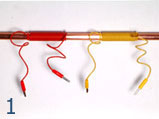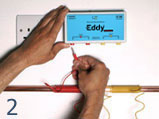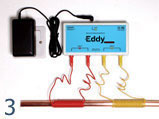A
Guide to Types of Water Treatment
Water
softeners and limescale treatments:
Electronic or
Magnetic Water Descalers
These devices operate by wrapping coils of wire or fixed magnets
around the incoming water main to pass a magnetic field through
the water. The causes the calcium in the water to stay in solution,
thereby inhibiting it from adhering to taps, baths and kettles.
Electronic descalers typically operate with one coil, but a
few (such as Eddy) use two. This feature increases the time
for which the water is exposed to the magnetic waveform.
Water
Softeners
A water softener works on the principle of cation (ion exchange)
in which ions of the hardness minerals (such as calcium and magnesium)
are exchanged for sodium or potassium ions, effectively reducing
the concentration of hardness minerals to tolerable levels. Water
softeners add a slight amount of salt to the water, which has
the effect of greatly reducing the amount of dissolved limescale
(which is released when the water is heated). They are suitable
for dishwashing or laundry, or other purposes where the water
is not directly used for consumption. The least expensive form
of water treatment, it can lead to streaking of glasses in glass
washers and over time, the salt can corrode welds on internal
pipe-work.
There
are three basic types of ion transfer softeners available on the
market:
Automatic
Softener
This type of softener is connected to a clock timer, which at
certain time intervals begins the renewal process by flushing
out the hard ions stuck to the resin and replacing them with the
soft ions. This then allows for a constant exchange of hard and
soft ions throughout the day.
Demand
Initiated Regeneration (DIR)
With a DIR, regeneration occurs only when soft water has run out.
Since this system adjusts to the amount of water utilized as opposed
to the automatic type, it uses less salt and water and is more
efficient.
Portable
Exchange
Here, a tank is rented to the homeowner and has a regenerated
resin. When the resin can no longer exchange ions, the tank is
returned to the company, where it is regenerated.
Water
filtering and disinfection:
Chlorination
Both municipal systems and households usually disinfect water
by adding chlorine. Chlorination does not remove nitrate or
other chemicals, but may oxidize organics and some other minerals
such as iron. Chlorine metering pumps have to be calibrated
and maintained carefully. Using a carbon filter after chlorination
removes any excess chlorine and chlorine-based chemicals that
may form.Distillation Units
Distillation removes
most impurities from water, including minerals such as sodium,
nitrate, and sulfate, and many organic chemicals. Distillation
units boil water to generate steam, which is then condensed
and collected as purified water. Most impurities remain in the
heating chamber and should be periodically removed. Units vary
from the kitchen countertop size to larger units.
De-alkalising
Units
These units are essentially remove the hardness are are commonly
reffered to as calcium treatment units. De-alkalising units are
suitable for steamers, combi-ovens, icemakers beverage machines
and vending machines.
De-mineralisation
Units
De-mineralisation removes almost all the dissolved minerals and
hardness in the water. These units are useful for glass washers
where there has been a history of smearing on glasses due to high
levels of dissolved salts in the washing water.
Activated
Carbon Filters
Activated carbon filters (also known as carbon or charcoal filters)
treat general taste and odour problems, including chlorine residue.
When water flows through carbon filters, contaminants adsorb or
stick to the surfaces of the carbon particles. Activated carbon
filters are considered the best method available for removing
specific organic chemicals, including some pesticide residues.
Mechanical
Filters
Mechanical filters trap, through a straining process, soil, sand,
and other suspended particles in water. These filters reduce turbidity
in water, and improve its appearance.
Iron
Removal Equipment
Iron and manganese can cause staining of clothes and plumbing
fixtures. While ferric (soluble) iron usually appears as rust
colored particles floating or settling in the water, ferrous iron
is in the dissolved form and cannot be seen in water. When water
containing ferrous iron is exposed to air, the iron oxidizes and
ferric iron is produced. Five types of iron-removal equipment
are available:
Iron
Filter
Iron filters are only useful for removal of soluble iron and manganese.
These filters look like water softeners but contain a bed of natural
or synthetic manganese green sand. Manganese dioxide oxidizes
iron and manganese, and the oxidized particles are then filtered
out in the lower part of the bed. Most such filters can remove
75 Ç 90% of ion in concentrations as high as 10 Ç
15 mg\litre.
Iron
removal
Water softeners contain a zeolite mineral in the resin that removes
soluble iron on an ion-exchange basis (the same way calcium and
magnesium are removed in water softening). Depending on the kind
of zeolite used and the regeneration process, up to 5 mg per litre
of soluble iron can be removed. The slime produced by iron bacteria
clogs the zeolite and reduces its effectiveness.
Polyphosphate
Feeders
These units can handle up to 3 mg\l of iron in solution. Polyphosphate
feeders contain a phosphate compound that coats the soluble iron
and prevents its oxidation when the water is exposed to air. The
compound is not effective against ferric iron that has already
oxidized. Polyphosphate is only helpful in treating cold water.
Heating the water releases the iron so that oxidized iron accumulates
in the water heater. This heated water will be rusty and unsatisfactory
for home use.
Chlorinator
and Filter
Chlorination followed by filtration through a sand filter can
remove iron in any form. The chlorine oxidizes and precipitates
the iron, and the filter filters out the particles. Carbon filtration,
however, may be required to remove excess chlorine residue. This
method also destroys iron bacteria. When the bacteria cannot be
permanently eliminated by shock chlorination, continuous chlorination
is needed.
Aerator
and Filter
An alternative to chlorination for iron removal is that of aeration
followed by filtration. An aerator introduces oxygen into the
water, thereby causing ferrous iron to precipitate through oxidation.
Neutralizers
This system treats corrosive (acidic) water by increasing alkalinity,
resulting in a pH near 7.0. Reducing corrosivity may also lower
the concentration of harmful metals, such as lead and copper,
that may be dissolved from pipe walls and fittings.
Reverse
Osmosis
A reverse osmosis unit substantially removes most suspended and
dissolved matter from water. The water is forced under pressure
through a very thin filtering membrane, like a sieve, that allow
water molecules, but not larger compounds. Water flushes away
the contaminants held by the membrane, thereby removing not just
the harmful limescale but also many other trace elements that
may change the flavour of beverages.






